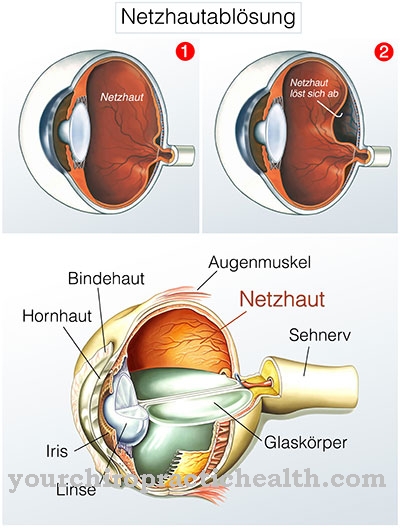Of the Femoral neck fracture or the Femoral neck fracture is an acute condition that is more common in the elderly and less so in the young or middle-aged. This fact also has a decisive influence on the healing time for a femoral neck fracture.
What is a femoral neck fracture?
.jpg)
© PATTARAWIT - stock.adobe.com
Behind the Femoral neck fracture, medically exact also as Femoral fracture or simply Femoral neck fracture called, the bone breaks through in the area of the thigh either on the left or on the right.
The femoral neck fracture is also known as a fracture near the hip due to its typical positioning. There are two variants of the femoral neck fracture. If the femoral neck fracture is stable, the treatment is very different from that in the case of an unstable femoral neck fracture.
In the case of a femoral neck fracture, different types of fractures are named depending on the localizable fracture points. In addition to the so-called medial femoral neck fracture, these are the lateral and pertrochanteric fractures.
In the medial fracture, the break runs below the femoral head and lies in the joint capsule. If the fracture line in the femoral neck fracture no longer runs in the joint capsule, it is referred to as a lateral fracture. Different therapeutic approaches also arise when it comes to the break line that is established between the femoral neck and the so-called bone shaft.
causes
The causes of the emergence of a Femoral neck fracture are usually based on excessive mechanical force. Be it through a fall or an accident, the bone is so enormously stressed in this context that it breaks.
The femoral neck fracture is favored by varying circumstances, which is also a sign of the massive accumulation in certain age and person groups.
In medicine, in addition to pathological impairment of the bone structure with increasing instability of the statics of the bone, the causes of a femoral neck fracture also include brief bending and shearing effects, i.e. falls.
Symptoms, ailments & signs
A fracture of the femur is usually preceded by a fall. The most obvious signs of a femoral neck fracture are severe pain in the hip or surrounding areas. For example, there may be pain in the thigh near the hip, or in the groin area. The affected leg is actively no longer mobile.
The pain increases with passive movement (by the doctor). If the femoral neck fracture occurs as a result of a fall, there may be bruises on the side of the thigh. If the fracture is displaced (dislocated fracture), the broken leg appears shorter than the other leg and is turned outwards. The leg can no longer be lifted straight from the surface.
Often all that is required here is a visual examination, which is then confirmed by an X-ray. Occasionally there is an indented fracture (broken bone). The ends of the break do not slip and the symptoms can be very inconspicuous. The patient does not see a doctor for days because his symptoms do not improve. The existing pain can be associated with a fall or accident. However, the person concerned suspects a bruise behind it, because in some cases he is still able to walk.
Diagnosis & course
Often a Femoral neck fracture can be recognized by a trained eye due to the misalignment of the thigh and the painful discomfort. These visible symptoms can be confirmed by palpation examinations by the specialist. In addition, an X-ray assessment is necessary, which is usually based on a so-called axial X-ray image.
The affected hip is x-rayed in the femoral neck fracture. In complicated cases, additional diagnostic procedures such as computed tomography can be used to clarify the extent of the femoral neck fracture.
When should you go to the doctor?
A doctor must be consulted if a femoral neck fracture is suspected. If the fracture occurs as part of an accident, it is best to call the ambulance as there may be other fractures or internal injuries. In addition, the risk of joint head necrosis, venous thrombosis and pulmonary embolism increases with every hour. The earlier the fracture is treated, the higher the chances of successful rehabilitation. Severe, stabbing pain in the area of the thigh indicates a fracture of the femoral neck that needs to be clarified and treated. Other warning signs include an abnormal position of the foot, swelling, bleeding, or problems moving the affected foot.
The risk groups include older people as well as athletes and people with physically demanding jobs. These people should take precautionary measures and, for example, always carry a mobile phone with them so that the emergency services can be called immediately in an emergency. A femoral neck fracture can be treated by an orthopedic surgeon. Severe fractures must be treated surgically, especially if there are nerve or muscle injuries. Follow-up treatment is carried out by the physiotherapist or sports doctor. In the case of severe fractures, it makes sense to stay in a rehabilitation center, where the injury can be cured under the supervision of specialists.
Treatment & Therapy
Treatment of the Femoral neck fracture depends on the diagnosis, whether it is a stable or unstable break and the extent of the break. If a stable femoral neck fracture is found, surgical intervention to straighten the fracture can be ruled out. Those affected are provided with adequate pain treatment and the fracture can heal under rest and with additional physiotherapy exercises.
Surgical treatment is essential if the femoral neck fracture is unstable. This is usually the case when the fracture points have shifted in the femoral neck fracture. This problem, which is also known as dislocation, can be compensated for by various surgical interventions. There is an option within modern surgical procedures for femoral neck fractures to consider either hip-preserving therapy or a replacement of the hip joint.
In addition, the treatment of a femoral neck fracture using the method known as intertrochanteric osteotomy is ideal for young patients.
In the first variant, special elements are screwed onto the femoral neck, which stabilize the fracture point again after a femoral neck fracture. For hip replacement, the surgeon inserts a head prosthesis or a total hip endoprosthesis in order to treat the area and regain mobility.
Outlook & forecast
The prognosis for a femoral neck fracture depends on how quickly surgical treatment is carried out. The sooner the surgical intervention takes place, the better the chances of recovery are usually.
The prognosis for a femoral neck fracture is often based on the extent of the circulatory disorders in the femoral head. For this purpose, doctors use a Garden classification. Garden I has a positive prognosis with a low risk of necrosis. With Garden II, too, the risk of necrosis is low and there is no displaced fracture. Garden III is used when the fracture has shifted without any shift in the posterior cortex. In addition, the necrosis rate is high. With Garden IV, the fracture fragments shift completely and there is an interruption in the vascular supply. Furthermore, the risk of femoral head necrosis is high.
The duration of the healing process for a femoral neck fracture also varies from patient to patient. Factors such as the age and activities of the patient play an important role. In addition, the patient should be mobilized again as quickly as possible after an operation. If, on the other hand, it remains in place for too long, there is a risk of muscle mass loss, which in turn has a negative effect on the chances of recovery. Rehabilitation, on the other hand, is beneficial for the prognosis, as it helps the patient to recover more quickly and to return to everyday life.
prevention
To one Femoral neck fracture To avoid this, it is important to counteract the effects of mechanical forces on this hip area. In the case of older people, this can be done by making areas of life at risk of falling barrier-free.
In addition, particularly restless, demented people can be equipped with so-called protective elements. These are known as protectors and are placed on both the hips and knees. These aids dampen the force of a fall and prevent a femoral neck fracture.
Treating vertigo symptoms and eating a high-calcium diet are also important. Additional physical exercise and sufficient fluid intake can also reduce the risk of a femoral neck fracture.
Aftercare
If the femoral neck hernia has to be operated on, it is important to give the patient injections against a possible thrombosis. The injections into the subcutaneous fatty tissue counteract a blood clot. Other useful aftercare measures include putting on special support stockings as well as physiotherapy exercises.
One of the goals of follow-up treatment is the rapid mobilization of the patient. The affected person can be mobilized again just 24 hours after the operation, which is carried out under the instructions of a physiotherapist. The patient also receives post-operative pain therapy.
The follow-up treatment of the femoral neck fracture takes about two to three weeks in hospital. The patient moves with the help of forearm crutches if he is not receiving load-stable treatment. If the patient received an artificial hip replacement during the operation, he or she is allowed to put full weight on the respective leg.
Lying down for too long is considered counterproductive in the case of a femoral neck fracture. Muscles are broken down and there is a risk of dangerous infections such as pneumonia. As a rule, follow-up treatment continues with rehabilitation after the hospital stay. This can also be carried out on a stationary basis if a supply within your own four walls is not possible. To do this, however, there must be a Barthel index of at least 70. The Barthel index is used to classify the need for care and everyday skills.
You can do that yourself
Unfortunately, there is little that patients with a fractured femur can do to speed the healing process. On the contrary: patience is the most important virtue. Depending on age, previous illnesses (e.g. osteoporosis), the fracture site and the treatment measure carried out, it can take up to six months for the femoral neck fracture to heal.
If the fracture has been operated on, the area around the wound should be kept clean and sterile, as otherwise wound healing disorders could occur. Infections are also common complications that can be avoided if the wound is taken care of carefully. Even if they are uncomfortable to wear: support stockings can prevent thrombosis. Regular physiotherapy can also prevent thrombosis and also ensure stable muscles and faster healing. Therefore, the patient should absolutely keep physiotherapy appointments.
Because older people are mostly affected by a femoral neck fracture, it is advisable to have all-round care as long as possible in a hospital or at home. The patient may only load the leg as much as the pain is bearable. Younger, active patients are even advised to only partially load the affected leg in order to prevent complications. Here those affected depend on the help of others.



.jpg)

.jpg)



















.jpg)

.jpg)
